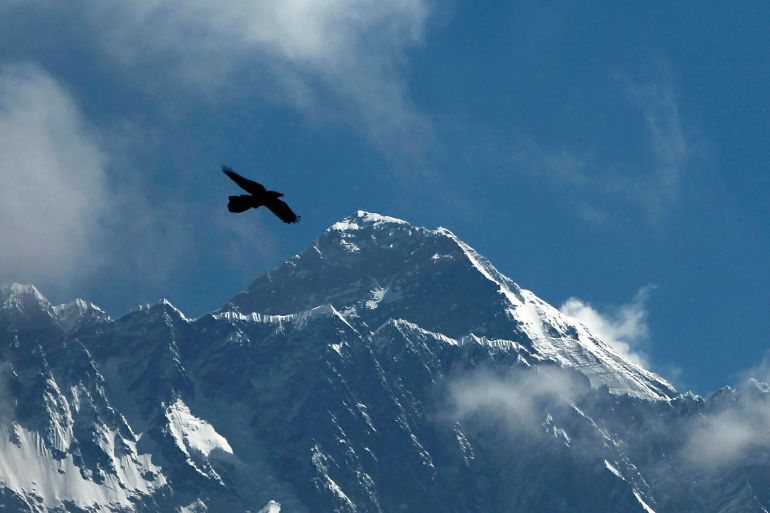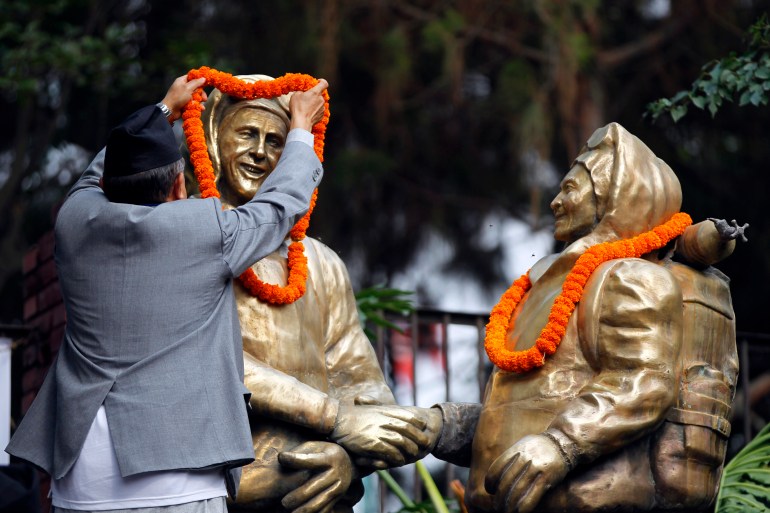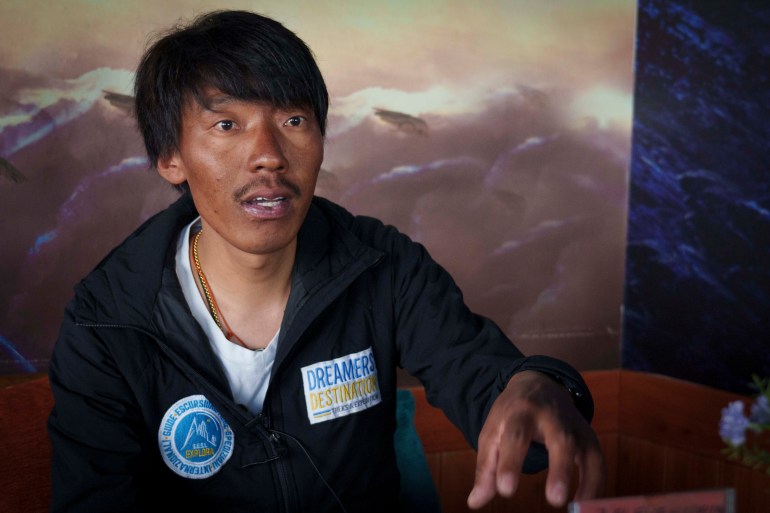Climbers to mark 70 years of Everest summit amid climate concerns
Conditions on the peak raise concerns for the mountaineering community and people whose livelihoods depend on the flow of visitors.

As the mountaineering community prepares to celebrate the 70th anniversary of the conquest of Mount Everest, there is growing concern about temperatures rising, glaciers and snow melting, and weather getting harsh and unpredictable on the world’s tallest mountain.
Since the 8,849-metre (29,032-foot) mountain peak was first scaled by New Zealander Edmund Hillary and his Sherpa guide Tenzing Norgay on May 29, 1953, thousands of climbers have reached the peak and hundreds have died.
Keep reading
list of 4 itemsFirst double amputee to climb Everest says will work for disabled
Two-thirds of glaciers projected to disappear by 2100: Study
Coping with climate change on Mt Everest
The deteriorating conditions on Everest are raising concerns for the mountaineering community and the people whose livelihoods depend on the flow of visitors.

Nepal’s Sherpa community, who grew up on the foothills of the snow-covered mountain they worship as the mother of the world, is the most startled.
“The effects of climate change are hitting not just the fishes of Antarctica, the whales or the penguins, but it’s having a direct impact on the Himalayan mountains and the people there,” said Ang Tshering, a prominent Sherpa who has been campaigning for years to save the Himalayan peaks and surrounding areas from the effects of global warming.
Almost every year, he and his Asian Trekking agency organise a cleaning expedition in which clients and guides alike bring down rubbish left by previous Everest climbing parties.
The effects of climate change and global warming have been severe in the high Himalayan area, Ang Tshering said. “The rising temperature of the Himalayan area is more than the global average, so the snow and ice is melting fast and the mountain is turning black, the glaciers are melting and lakes are drying up.”
Growing up on the foothills of the mountain, Ang Tshering said he remembers sliding on the glacier near his village. But that is gone now.
2,000 years of ice lost in 30 years
Other Sherpas also said they have seen the changes in the Khumbu Glacier at the foot of Everest, near the base camp.
“We don’t really need to wait for the future; we are seeing the impact already,” said Phurba Tenjing, a Sherpa guide who recently scaled the peak for the 16th time guiding foreign clients to the summit.

Phurba Tenjing has been climbing Everest since he was 17. He said both the snow and ice have melted and the trek that used to take five or six hours over the icy path now only takes half an hour because the glaciers have melted and bare rocks are exposed.
“Before, the building-like ice chunks of the Khumbu Glacier used to come all the way up to the base camp. But now we don’t see it near the base camp,” Phurba Tenjing said.
Recent research found that Mount Everest’s glaciers have lost 2,000 years of ice in just the past 30 years.
Researchers found that the highest glacier on the mountain, the South Col glacier, has lost more than 54 metres (177 feet) of thickness in the past 25 years.
The glacier sits about 7,900 metres (26,000 feet) above sea level and was found to be thinning 80 times faster than it first took the ice to form on the surface.
The glaciers are losing ice at rates that likely have no historic precedent, said Duncan Quincey, a glaciologist at the University of Leeds in the United Kingdom.
The change is happening “extremely rapidly” he said. “It’s causing challenges for everybody within that region and, of course, for the millions of people who are living downstream,” since much of South Asia depends on rivers that originate in the Himalayas for agriculture and drinking water.
Floods and droughts are likely to become more extreme, he said.
“There’s a huge amount of unpredictability within these systems now, and it makes it very difficult for people who require water at a particular time of year to know that they’re going to have that water available,” he said.
Nepal’s government and mountaineering community plan to celebrate Everest Day on May 29 with a parade around Kathmandu and a ceremony honouring the climbers and veteran Sherpa guides.